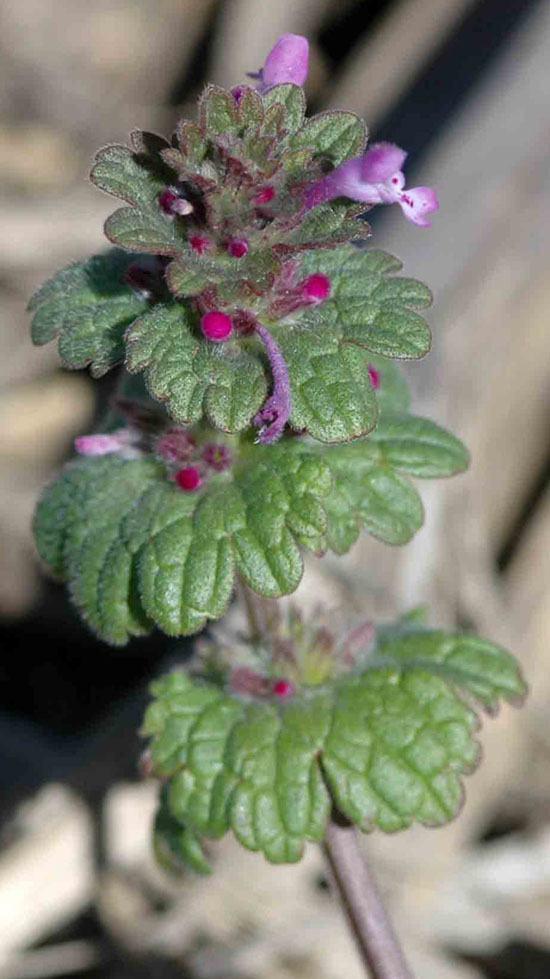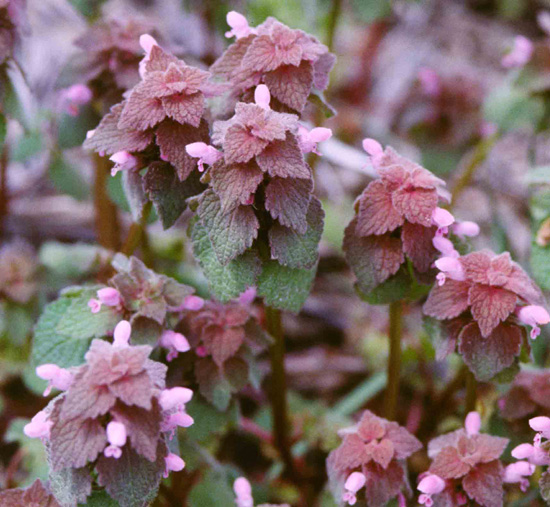Splashes of color are becoming evident across the otherwise drab landscape in Illinois and other states. Purple is currently most common, but white and yellow soon will follow.

The upper leaves of henbit lack petioles.
The two winter annual weed species producing the "purple patches" are henbit (Lamium amplexicaule) and purple deadnettle (L. purpureum). Although close relatives taxonomically, henbit and purple deadnettle are distinctively different species.
Both are winter annuals (although spring emergence has been known to occur), and both species have square stems characteristic of the mint (Lamiaceae) plant family.
The lower leaves of henbit are petiolate (attached to the stem with petioles), while the upper leaves grasp the stem (i.e., lack petioles). The upper leaves of purple deadnettle, however, are attached to the stem with petioles, are more triangular than those of henbit, are less deeply lobed, and tend to be reflexed, or pointed downward.
As the name indicates, purple deadnettle has distinctive reddish to purple coloration of the foliage and stem.
Flowering indicates that henbit is close to completing its life cycle and will likely be more difficult to control with burndown herbicides, but this does not mean that no attempt should be made to control existing plants before corn or soybean planting.
Henbit and purple deadnettle are known to be hosts for a number of insect and disease pests, and mature seeds can survive in the soil seedbank for several years. Planting into dense patches of these species can be challenging and could result in poor seed placement. Herbicides can provide good to excellent control of existing henbit and purple deadnettle.

The upper leaves of purple deadnettle are triangular and are attached to the stem with short petioles.
In general, 2,4-D and dicamba are weak on henbit. Glyphosate can provide good control, but application rates should be at close to 1.1 lb ae/acre for these mature plants.
Combining glyphosate and 2,4-D or adding these two herbicides to other residual herbicides is a popular broad-spectrum burndown. Atrazine (1.5-2 lb/acre) or atrazine-containing premixes have good activity on henbit, and adding crop oil concentrate often improves burndown activity.
Control with paraquat is often improved when combined with atrazine or metribuzin. Saflufenacil alone can be weak on henbit, but control can be improved when it is combined with atrazine and/or glyphosate ± 2,4-D.
Cool temperatures can slow the activity of many burndown herbicides, and translocated herbicides sometimes act more slowly than contact herbicides under these conditions.
Contact herbicides may not be as slow to act as translocated herbicides under cool conditions. When the forecast calls for several days or nights of cool air temperatures, don't be surprised if symptoms of activity on existing vegetation take several days to develop.






Post a comment
Report Abusive Comment